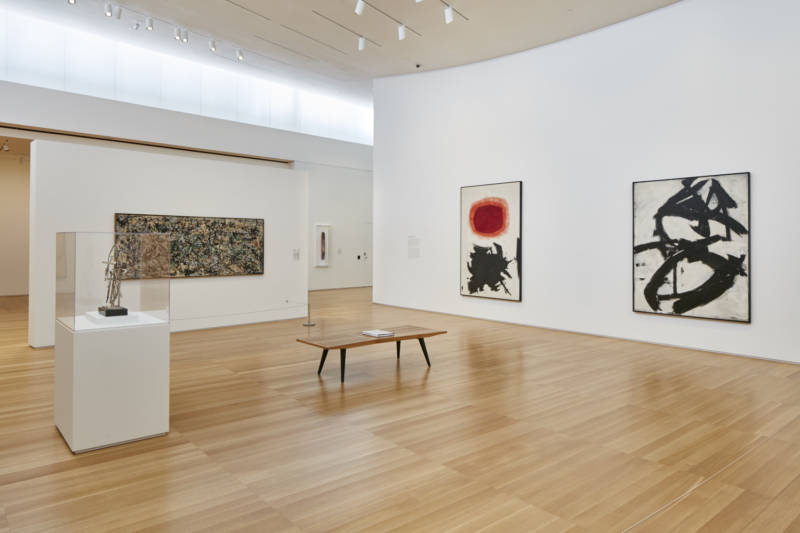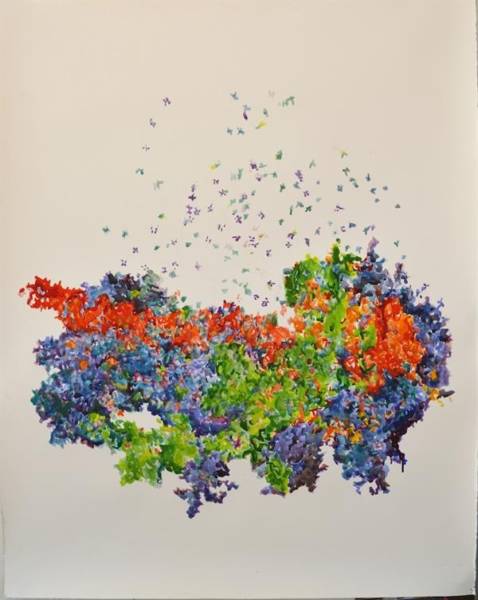The coming relaunch of the San Francisco Museum of Modern Art has lots of people buzzing in anticipation. But downtown San Francisco is not the only place where truly exciting things are happening on the visual arts front.
Super-star artist James Turrell, for instance, is touching down in Palo Alto with a pocket-sized exhibition this week, ahead of the re-opening of a major retrospective of his work at The Los Angeles County Museum of Art in late May.
Turrell is famous for his meditations on light and space that play with your depth perception. Take the most eye-catching piece in the inaugural show at the newly opened Pace Gallery in Palo Alto. Pelée is a curvaceous LED screen that looks like a window — or really, more like an opening in the wall to another world.
“You’ll see reds, and that can fade into other colors,” says Pace Palo Alto President Elizabeth Sullivan. “It’s just beautiful, mesmerizing, really meditative in a way.”
Sullivan figures the most casual passer-by will be entranced by the light of the artwork spilling out onto the street. Even those unfamiliar with Turrell’s work may have been exposed by Drake’s video for “Hotline Bling,” albeit without Turrell’s consent: his work was ripped off. (For the record, Turrell has reportedly said he’s not that irked by the hip hop artist’s co-option of his art.)
Pace, which has represented Turrell for years, is a bit of an art world celebrity, too. The global art gallery empire, based in New York with four galleries there, maintains outposts in London, Paris, Beijing and Hong Kong.
Sullivan won’t say why Pace picked Palo Alto over more obvious choices like San Francisco or Los Angeles. But the local community is happy about the choice. “People in the art world are so excited that Pace would choose to come to Silicon Valley,” says Cathy Kimball, executive director of the San Jose Institute of Contemporary Art.
Pace started on the Peninsula with a “pop-up” gallery in Menlo Park in a converted Tesla showroom, slated for demolition sometime next year. There were a handful of solid exhibitions featuring names like Alexander Calder and Tara Donovan. Then came a blockbuster by a Japanese group called teamlab, which makes ancient Japanese art come alive in floor-to-ceiling digital animations.
From her vantage point to the south, Kimball looked on with some envy as Pace drew in 45,000 people in less than three months. “That teamlab animation is something to marvel at,” Kimball says. “It’s immersive. It’s so animated. There’s so much to look at.”
Kimball insists she’s not really feeling competitive with Pace, though she wishes her organization had resources more in line with the shiny new neighbor up the road. “Pace certainly has a kick ass team,” Kimball says. “They also have a kick ass budget. There aren’t a lot of us who can mount a Turrell show or a teamlab show in the degree that they did in Menlo Park.”
Pace is not the only big art muscle flexing on the Peninsula. In the last five years, Stanford has built an entire “arts district” in the heart of its campus. The site includes a new museum next to the Cantor Arts Center built to house the personal collection of one local family, the Andersons.

On a recent Saturday, a group of curators, gallery owners, collection managers, and other visual arts professionals took a private tour of the museum. The tour was put together by the local chapter of Art Table, a non-profit that usually organizes special events like this one in San Francisco and the East Bay.
But that’s changing, says chapter co-chair Kathy Kenyon. “I think it’s real exciting what they’re doing here with this whole arts section, with the Anderson Collection, and bringing over the art department so that it is directly connected with the museums here is a huge thing,” Kenyon says. And all of Stanford’s art collection is available to the public for free.
There’s more to the scene than the high profile glamour of Stanford and Pace. Municipalities on the Peninsula are also doing a fair bit to nurture local talent. A number of them, including Redwood City, commission and exhibit local artists. Palo Alto goes a step further, providing studio space for 25 artists.

“Artists and arts groups can be considered here an endangered species,” says Rhyena Halpern, who oversees the city’s public investment in the arts as assistant director of Palo Alto’s Community Services Department. “Because the cost of living is so high, and the cost of doing business is so high.”
But the very same economic boom has created more people in a position to invest in art. Pace, Halpern says, could well be the harbinger of things to come. “That they took this risk to come here to see what they could do, see if there was a collector base they could tap into: very smart,” Halpern says. “But what it gives the community in return is this amazing access. You know, down the street. It’s incredible!”